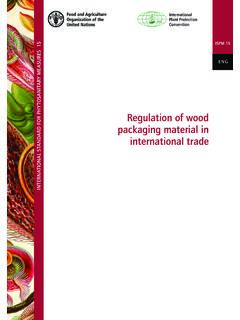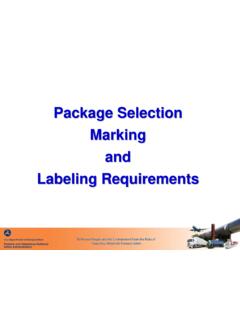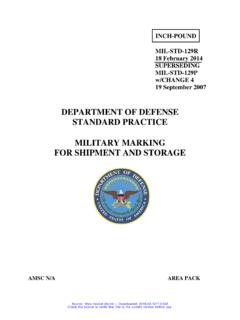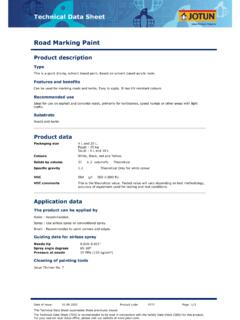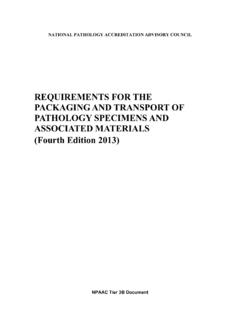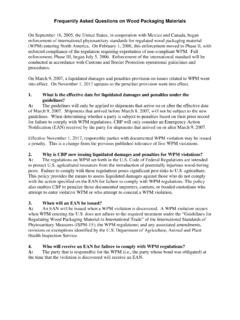Transcription of Steel for packaging Product catalogue
1 Flat Carbon Europe Steel for packaging Product catalogue user manual Sollight . Product catalogue Steel for packaging Editorial 5. Steel for packaging production processes 7. Product offer 15. Steel solutions for packaging 23. Global presence 37. 1 Editorial Steels for packaging are thin gauge flat carbon steels, tin or chromium coated on both sides. This particular combination gives the tinplate an interesting set of properties: strength and stiffness, formability, weld- ing ability, lacquer ability and printability, good cosmetic appearance and corrosion resistance.
2 These properties bring appropriate response to all the necessary requirements: content protection during stocking and transportation, safe food preservation, printed information for the final user, ease of use, sustainability and environmental friendliness. Mass production of tinplate for canning human food started in year 1810, when Nicolas Appert wrote a famous book describing the tech- nique of sterilization (also called appertization ) to preserve the food and when Peter Durand patented the same year the use of metal cans for the foodstuffs.
3 Since then, tinplate has constantly taken advantage of dramatic improve- ments, especially over the past decades: improvements of the Steel production processes (lower melting residuals and better inclusion cleanliness, switch from ingots to continuous casting, better temperature controls during hot rolling, high precision cold rolling), improvements of the coating process (hot dip tinning replaced by electro tinning to reduce the thickness of the tin layer), improvements of lacquers to increase the corrosion resistance, switch from soldering to electric welding for the can bodies.
4 Unlike any other packaging material, Steel is 100% infinitely recyclable and recycled. Thanks to its magnetic properties, Steel packaging is the easiest and most economical type of packaging to sort and recover for recycling. Regard- less of how many times it is recycled, Steel loses none of its strength or inherent properties. The reuse and recycling cycle of Steel is a never- ending process. Its unlimited lifespan and the potential for perpetual recyclability without detriment to its mechanical properties place the sustainability advantage firmly in the hands of Steel .
5 With Steel , natural resources are saved for future generations and total energy use and CO2 emissions are significantly reduced. In fact, each item of recycled Steel packaging saves one and a half times its weight in CO2. In other words, the more Steel is recycled, the greater the reduction in CO2 emissions. In 2011, 74% of Steel packaging has been recycled in Europe, with strong growth recorded across the continent. That amounts to over 5. million tonnes of Steel containers being recycled and saves million tonnes of CO2 emissions from being released into the environment.
6 At ArcelorMittal, thanks to our R&D capabilities, we offer the most advanced Steel solutions for packaging applications such as easy open ends, ultra thin gauges for bodies, crown corks or caps, weld-free DWI cans (drawn and wall ironed) or Steel can compatibility with microwave food heating. We support can weight lightening trends. We promote ecodesign and resource efficiency. Our aim is to constantly improve our environmental performance while managing the impact induced by our activities, products and services on the environment.
7 All our Steel for packaging production plants are certified ISO 14001 and complying with the Environmental Policy of ArcelorMittal. Continuous improvements of processes - growing material efficiency, energy consumption reduction, and increased Steel recycling - have resulted in a significant decrease in the CO2 impact of our Steel products. Over the past 30 years we have reduced our carbon footprint in Europe by more than 50%. Steel for packaging is the solution for a sustainable future. Enjoy discovering the ArcelorMittal offer in this catalogue .
8 /. 2 Steel for packaging production processes Structure of the coated Steel strip 8. Overview of the packaging Steel process 9. Steel grades and Steel processes 10. Chemical composition 10. Steel ageing 10. Cold metallurgical process 11. Cold Rolling 11. Continuous Annealing (CA) or Batch Annealing (BA) 11. Temper Rolling 11. Coating 12. Tin coating 12. Passivation 13. Chromium coating 13. Oiling 13. 7. 2 Steel for packaging production processes Structure of the coated Steel strip packaging Steel sheet is a composite multilayer Product : Example of tinplate tin coating + passivation 311.
9 Steel substrate . iron-tin alloy layer FeSn2 (thickness m). tin layer Sn (thickness m). passivation 311: Cr + Cr203 (thickness m). oil film (thickness m). Example of electrolytic chromium coated Steel . Chromium coating . Steel substrate chromium layer Cr + Cr 0 2 3 (thickness m). oil film (thickness m). 8 Product catalogue Steel for packaging ArcelorMittal Overview of the packaging Steel process Making a tinplate can is a complex multi-stage process: Hot phase Blast furnace to produce pig iron from iron ore and coal coke.
10 Oxygen Steel furnace to transform the pig iron into low carbon Steel with the correct chemical composition and specifications. Continuous casting to transform the liquid Steel into solid slabs (typical thickness 235 mm). slabs coils Hot rolling (temperature range 900/1200 C) to transform the slabs into hot rolled coils (thickness range to mm, typical width 800- 1300 mm and typical weight 25 tonnes or more). slabs coils Cold phase Pickling to remove scale from the surface. Cold rolling to reduce the strip thickness close to the requested final gauge.

